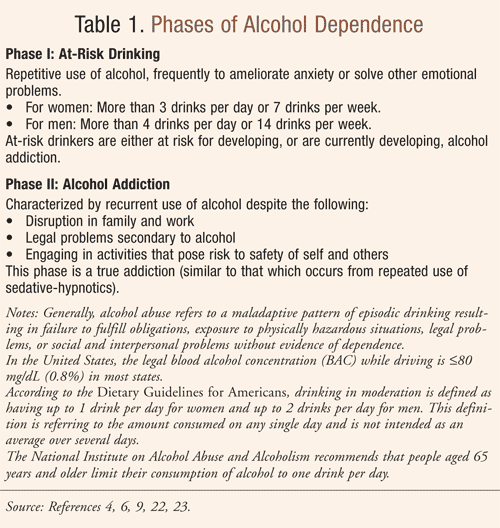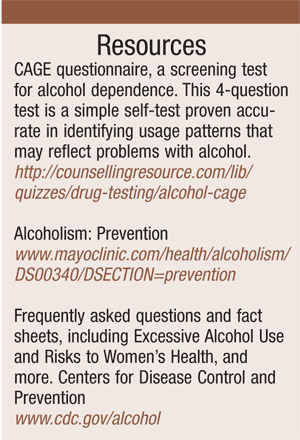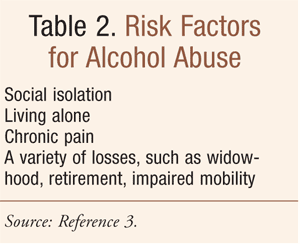Alcohol abuse is a major public health problem in the United States that causes many chronic diseases and injuries with an inordinate amount of mortality.1,2 Alcohol abuse often goes unrecognized by clinicians, mistaken for indications of other age-related problems such as depression and dementia.1,3 Alcoholism, also referred to as alcohol dependence, is a syndrome consisting of two phases—at-risk drinking and alcohol addiction ( TABLE 1 ).4 It is estimated that direct and indirect health and social costs to the nation from alcoholism are approximately $185 billion annually.5

Due to patient denial and lack of detection of clinical clues, alcohol dependence is substantially underdiagnosed and undertreated.1 It has been estimated that only 25% of patients with alcohol dependence have ever been treated.1 Alcohol abuse (See Notes, TABLE 1) , is associated with lifetime prevalence of approximately 18%.1 The lifetime prevalence of alcohol dependence (TABLE 1) reaches approximately 13%. In men, whites, and younger and unmarried individuals, prevalence rates appear to be higher.1
As women age, however, they may be especially at risk for alcohol-related problems, since they become more likely than men to outlive their spouses and face additional losses that may lead to loneliness and depression; they also have a greater physiological risk for alcohol-related health problems as they age.6 Senior women also have a heightened response to prescribed and OTC medications.6 It has been suggested that in senior women, screening (see below and RESOURCES) and brief intervention may be especially useful in minimizing problems with alcohol.6 (For additional information on screening and excessive alcohol use and risks to women’s health, see RESOURCES). Alcohol use recommendations for senior women and men (TABLE 1) are generally lower than those recommended for younger adults.6

When the elderly are seen in health care settings, 6% to 11% show symptoms of alcoholism; this figure increases to 14% in the emergency department and 20% in the psychiatric setting.3 The elderly are often not considered to be alcoholics, and owing to alcohol’s ubiquitous nature—from social celebrations to religious rituals—attitudes about its use vary from one health care professional to another.7 However, because of ethanol’s (ethyl alcohol) anxiolytic and sedative (and ultimately hypnotic) effects, its toxic potential outweighs its benefits.8
Physiological Impact
Organ damage occurs secondary to alcoholism; gastritis, severe liver disease (hepatitis and cirrhosis), pancreatitis, and nutritional deficiencies can occur; heavy drinking may cause cardiomyopathy, often accompanied by arrhythmias.8,9 Peripheral neuropathy and brain damage (e.g., Wernicke’s encephalopathy, Korsakoff’s psychosis, Marchiafava-Bignami disease, alcoholic dementia) may also occur.9 The consumption of alcohol increases the risk of cancer of the mouth, throat, esophagus, liver, colon, and breast among women; the risk of breast cancer increases as alcohol use increases.10-13
Other sedatives may be synergized by ethanol, and severe central nervous system depression can occur with benzodiazepines, antihistamines, or barbiturates.8 Falls can occur. There is a risk of other drug-ethanol interactions, especially in the elderly, who are more likely to have multiple comorbidities with extensive medication regimens that often consist of potentially inappropriate medications, increasing the likelihood of medication-related problems.14,15
Risk Factors and Comorbidities
Risk factors for alcoholism are listed in TABLE 2
.
It has been shown through pharmacogenomic studies that genotypic and
functional phenotypic variants exist and serve either to protect
patients from or predispose them toward alcohol dependence.16 Alcohol dependence often coexists with other substance-use disorders, as well as mood, anxiety, and personality disorders.1,7
In older alcoholics, comorbid depression frequently places them at
greater risk for suicide; alcohol abuse or dependence is higher in
patients with cognitive impairment.7 Determining whether a referral to a mental health practitioner is warranted is an important consideration.7

Since stress may trigger the overuse of alcohol, seeking assistance (e.g., of a social worker) to provide couples and family interventions may help ameliorate this trigger.3
Diagnostic Criteria
A hallmark criterion for the diagnosis of alcohol dependence is physiological dependence, which is manifested by evidence of withdrawal upon the interruption of alcohol intake.1 Other major diagnostic criteria include tolerance to the effects of alcohol, alcohol-associated disorders (e.g., alcohol-associated liver disease), and ongoing alcohol consumption despite significant medical and social contraindications and disruptions in living. Additionally, experiencing social- and occupational-functioning impairment, depression, and blackouts are major criteria for the diagnosis of this condition.
According to Pignone and Salazar, other signs include: 1) stigmas associated with alcoholism, including alcohol odor on breadth, alcoholic facies, facial flushing, scleral injection, tremor, ecchymoses, and peripheral neuropathy; 2) surreptitious drinking; 3) unexplained absenteeism from work; 4) frequent accidents, falls, or injuries of vague origin; cigarette burns on the hands or chest may be seen in smokers.1 Laboratory evidence helpful in the diagnosis includes elevation of the following values: 1) liver-function tests; 2) mean corpuscular volume; 3) serum uric acid; 4) triglycerides.1
Screening for Alcohol Abuse and Dependence
The four component questions of the CAGE questionnaire (see RESOURCES ), while not a complete patient evaluation, can provide a useful starting place. This tool is helpful for detecting individuals who are more likely to be alcohol abusers and at greater risk for alcohol withdrawal.
Management
Goals of treatment for the alcohol-dependent individual attempting to decrease or discontinue alcohol intake include 1) prevention and treatment of withdrawal symptoms (including seizures and delirium tremens) and complications, 2) long-term abstinence following detoxification, and 3) initiation into ongoing medical and alcohol-dependence treatment.2
Management of Alcohol Withdrawal
The treatment of alcohol withdrawal can take place in hospitals, inpatient detoxification units, or outpatient settings.2 Benzodiazepines are the agents of choice to prevent and treat alcohol withdrawal.2,7,8 An example of a typical regimen is lorazepam 2 mg every hour as needed, when symptoms are in the moderate-to-severe range as indicated by scores on a structured assessment scale (e.g., Clinical Institute Withdrawal Assessment—Alcohol, revised; see Reference 17).2 Since lorazepam can be administered IV, intramuscularly (IM), and orally—all with predictable results—it is the benzodiazepine preferred by many clinicians.2 There is less evidence-based support for the use of barbiturates for alcohol detoxification; other agents that can reduce the symptoms of alcohol withdrawal include clonidine, carbamazepine, vigabatrin, valproic acid, gabapentin, and topiramate.2
Seizures secondary to alcohol withdrawal do not require treatment with an anticonvulsant drug unless status epilepticus occurs; those patients with a history of withdrawal seizures should receive a higher initial dose of a benzodiazepine and a slower tapering period of 7 to 10 days.2
Alcohol-Induced Hypoglycemia: Alcohol has the ability to significantly lower blood glucose, causing hypoglycemia. A blood glucose level should always be obtained in individuals who are brought to medical attention for alcohol-related symptoms.18 Further, alcohol-induced hypoglycermia can be mistaken for intoxication.18 Of note, when alcoholics are being hydrated with dextrose (typically D5-0.45 NS with 20 mEq of KCL per liter), thiamine (vitamin B1) stores are utilized due to an increase in glucose metabolism.2,18 It is imperative, therefore, to also administer thiamine prior to fluids and glucose to avoid permanent neurologic damage due to Wernicke-Korsakoff syndrome.18 (See also Vitamin Deficiency, below.)
Vitamin Deficiency and Electrolyte Abnormalities: Deficiency of thiamine may be seen among alcoholics, particularly those with poor nutrition.2,9 Symptoms include polyneuropathy (diffuse), heart failure (high-output), and Wernicke-Korsakoff syndrome. Supplementation to prevent this occurrence is commonly dosed initially with thiamine 100 mg IV or IM; evidence of thiamine deficiency requires supplementation with 100 mg orally daily for 1 to 4 weeks.2
Of note, alcoholism may aggravate dietary folate deficiency causing mild neutropenia.19 This is important information for those who serve seniors, since elders living alone may not receive nutritionally balanced diets secondary to socioeconomic, psychological, or medical reasons. Natural dietary sources of folates are found in fresh green leafy vegetables, many fruits, and beans.19
Clotting factors may be abnormal due to decreased liver function and a relative inability to produce vitamin K–dependent clotting factors; prescribed supplementation with 2.5 to 25 mg of vitamin K can be used.2 Electrolyte abnormalities may require replacement of potassium, phosphorus, and magnesium.2
Pharmacologic Management of Alcohol Dependence
The clinical usefulness of the following three FDA-approved medications for the treatment of alcohol dependence to improve sustained abstinence remains controversial; relapse is common.
Disulfiram (125-500 mg orally every morning) is an acetaldehyde dehydrogenase inhibitor that blocks the oxidation of acetaldehyde to acetic acid, resulting in the accumulation of acetaldehyde in the blood and causing an aversive reaction (known as a disulfiram-alcohol reaction): flushing, tachycardia, hyperventilation, and nausea.8 This agent works as a deterrent to the resumption of drinking alcohol; however, studies have failed to prove it effective.2 Additionally, it has significant adverse effects and is poorly tolerated.1,20 Disulfiram use in the elderly has been rare due to its adverse reaction profile, and overall, its use has fallen out of favor.2,7 While renal and hepatic dosing are not defined, caution is advised in patients with renal or hepatic impairment.20
Naltrexone (50 mg orally once daily) is a long-acting opiate antagonist and should be utilized in conjunction with supportive psychotherapy.8,20 Of note, the patient must be opioid free for 7 to 10 days before initiation of therapy.20 This agent is used for abstinence maintenance, initiated after withdrawal; drug therapy is continued even if relapse occurs.20 While studied mainly in the general adult population, this agent has been shown to have similar effectiveness in older adults, and improvement in relapse to heavy drinking in one study of individuals aged 50 to 70 years.7 The IM, long-acting dosage form of naltrexone (380 mg IM every 4 weeks) has been shown to reduce drinking significantly (compared with placebo) among treatment-seeking alcoholics over a 6-month period.1,20 Naltrexone is better tolerated than disulfiram and does not elicit the aversive reaction that disulfiram does.8 While renal and hepatic dosing are not defined, caution is advised in patients with renal or hepatic impairment; this drug is contraindicated in patients with acute hepatitis or hepatic failure.20
Acamprosate (666 mg orally 3 times daily) is a glutamate modulator at the N-methyl D-aspartate (NMDA) receptor, and although its mechanism of action is not fully defined, it restores the balance to gamma-aminobutyric acid (GABA) and glutamate activities, which are thought to be disrupted in alcohol dependence, and reduces alcohol craving.1,20,21 This agent should be utilized in conjunction with supportive psychotherapy.8 When used therapeutically, it reduces alcohol intake without causing a disulfiram-like reaction following alcohol ingestion.21 Since a very small number of patients were older than 65 years in the initial clinical trials, and no patients included were over the age of 75, it is not possible to derive sufficient data to compare elderly to younger adults.21 Since this agent is exclusively renally excreted, caution is advised in dosing patients with renal impairment (CrCl 30-50 mL/min) in whom dosage reduction is required; this drug is contraindicated in patients with a CrCl of less than 30 mL/min.21
Examples of other agents used off label for alcohol dependence include bupropion, various serotonergic agents, and lithium.2
Psychological, Social, and Behavioral Management
Social workers provide useful and successful educational interventions with seniors who are not aware that they are consuming too much alcohol. Support groups for elders focus on self-help issues and can help older adults learn to deal with problems such as alcoholism.3 A self-help group (e.g., Alcoholics Anonymous) or psychoeducational group approach has been shown to be effective in alcohol abusers; a cognitive behavioral approach, in both individual and group sessions, is also effective.3 Pharmacists intervene with those who are not aware they may be misusing OTC medications or that alcohol may interfere with their prescribed and OTC medications.3 Social workers, counselors, psychologists, psychiatrists, and pharmacists are accessible in a variety of settings, including nursing homes, community mental health facilities, hospitals and health care facilities, hospice, ambulatory care, and home care.
For an expanded discussion of the pharmacology and pharmacokinetics of alcohol and alcohol poisoning, and the nuances of dosing pharmacologic agents used in the treatment of alcohol withdrawal (including alcoholic hallucinosis, seizures and delirium tremens), consult to Reference 2. See RESOURCES for information on the prevention of alcoholism and additional topics.
Conclusion
Alcoholism is a serious medical and social problem that imposes enormous human and economic costs on society. Further, it is a syndrome that is substantially underdiagnosed and undertreated. Pharmacists should be ready, willing, and able to assist with the recognition and treatment of alcohol dependence.
REFERENCES
1. Pignone M, Salazar R. Disease prevention & health promotion. In: McPhee SJ, Papadakis MA, Rabow MW, eds. 2011 Current Medical Diagnosis & Treatment. 50th ed. New York, NY: McGraw Hill Medical; 2011:18-21.
2. Doering PL, Kennedy WK, Boothby LA.
Substance-related disorders: alcohol, nicotine, and caffeine. In: DiPiro
JT, Talbert RL, Yee GC, et al, eds. Pharmacotherapy: A Pathophysiologic Approach. 7th ed. New York, NY: McGraw-Hill Inc; 2008:1083-1097.
3. Dunkle RE, Dennis MC. Social work. In: Halter JB, Ouslander JG, Tinetti ME, et al, eds. Hazzard’s Geriatric Medicine and Gerontology. 6th ed. New York, NY: McGraw-Hill; 2009:317-323.
4. Eisendrath SJ, Lichtmacher JE. Psychiatric disorders. In: McPhee SJ, Papadakis MA, Rabow MW, eds. 2011 Current Medical Diagnosis & Treatment. 50th ed. New York, NY: McGraw Hill Medical; 2011:1037-1040.
5. Harwood H. Updating estimates of the
economic costs of alcohol abuse in the United States: estimates, update
methods, and data. Report prepared by The Lewin Group for the National
Institute on Alcohol Abuse and Alcoholism. 2000.
http://pubs.niaaa.nih.gov/publications/economic-2000/index.htm. Accessed
August 17, 2012.
6. Blow FC, Barry KL. Use and misuse of
alcohol among older women. National Institute on Alcohol Abuse and
Alcoholism, National Institutes of Health. Department of Health and
Human Services. Published June 2003.
http://pubs.niaaa.nih.gov/publications/arh26-4/308-315.htm. Accessed
August 17, 2012.
7. Husain MM, McClintock SM, Queenan KE,
et al. General topics in geriatric psychiatry. In: Halter JB, Ouslander
JG, Tinetti ME, et al, eds. Hazzard’s Geriatric Medicine and Gerontology. 6th ed. New York, NY: McGraw-Hill; 2009:865-871.
8. Harvey RA, Champe PC. Pharmacology, 4th ed. Philadelphia, PA: Lippincott Williams & Wilkins; 2009:105-116.
9. Alcohol. Drug use and dependence. Merckmanuals.
com. Reviewed July 2008. www.merckmanuals.com/pro
fessional/special_subjects/drug_use_and_dependence/alcohol.html?qt=alcoholdependence&alt=sh#v1026823.
Accessed August 28, 2012.
10. Baan R, Straif K, Grosse Y, Secretan
B, et al. on behalf of the WHO International Agency for Research on
Cancer Monograph Working Group. Carcinogenicity of alcoholic beverages.
Lancet Oncol. 2007;8:292–293.
11. Smith-Warner SA, Spiegelman D, Youn SS, et al. Alcohol and breast cancer in women: a pooled analysis of cohort studies. JAMA. 1998;279:535–540.
12. Thun MJ, et al. Alcohol consumption and mortality among middle-aged and elderly U.S. adults. N Engl J Med. 1997;337:1705–1714.
13. Department of Health and Human
Services. Tenth special report to the U.S. Congress on alcohol and
health. Bethesda, MD: National Institutes on Alcohol Abuse and
Alcoholism; June 2000.
http://pubs.niaaa.nih.gov/publications/10report/intro.pdf. Accessed
August 17, 2012.
14. Zagaria ME. Assessing and monitoring medication therapy in seniors. Am J Nurse Prac. 2011;15:48-52.
15. Zagaria ME. Medication-related problems in seniors: Risk factors and tips for appropriate prescribing. Am J Nurse Prac. 2009;13:23-27.
16. Bierut LJ, Saccone NL, Rice JP, et
al. Defining alcohol-related phenotypes in humans. The collaborative
study on the genetics of alcoholism. Alcohol Res Health. 2001;3:217-232.
17. Sullivan JT, Sykora K, Schneiderman
J, et al. Assessment of alcohol withdrawal: the revised clinical
institute withdrawal assessment for alcohol scale (CIWA-Ar). Br J Addict. 1989;84:1353-1357.
18. Cavan Frisch N, Frisch LE. Psychiatric Mental Health Nursing. 3rd ed. Clifton Park, NY: Delmar Cengage Learning; 2006:367, 709.
19. Klepin HD, Powell BL. White cell disorders. In: Halter JB, Ouslander JG, Tinetti ME, et al, eds. Hazzard’s Geriatric Medicine and Gerontology. 6th ed. New York, NY: McGraw-Hill; 2009:1217.
20. Epocrates, Version 4.1. Epocrates, Inc. www.epocrates.com. Accessed August 15, 2012.
21. Semla TP, Beizer JL, Higbee MD. Geriatric Dosage Handbook. 16th ed. Hudson, OH: Lexi-Comp, Inc; 2011.
22. U.S. Department of Agriculture and
U.S. Department of Health and Human Services. Dietary Guidelines for
Americans, 2010. Chapter 3. Foods and food components to reduce. 7th ed.
Washington, DC: U.S. Government Printing Office; 2010; 30-32.
www.cnpp.usda.gov/Publications/DietaryGuidelines/2010/PolicyDoc/Chapter3.pdf.
Accessed March 8, 2012.
23. National Institute on Alcohol Abuse
and Alcoholism, National Institutes of Health, U.S. Department of Health
and Human Services. Alcohol in women’s lives: safe drinking over a
lifetime. Revised 2008.
http://pubs.niaaa.nih.gov/publications/brochurewomen/women.htm#lifetime.
Accessed August 17, 2012.
To comment on this article, contact rdavidson@uspharmacist.com





